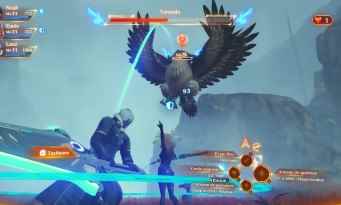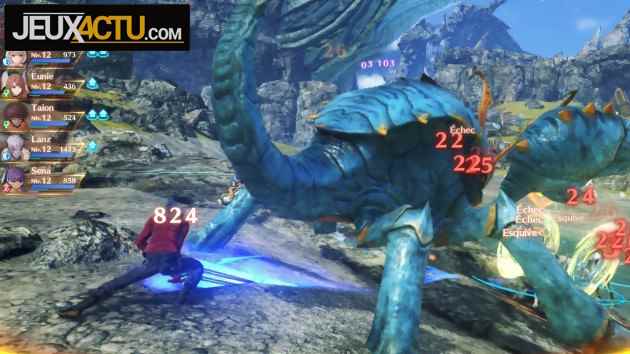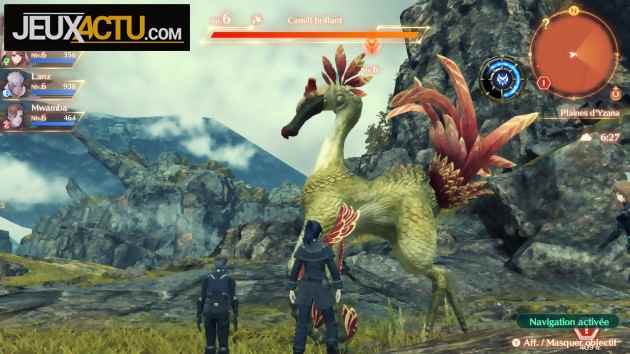The Xenoblade Chronicles saga, itself more or less derived from the Xenogears and Xenosaga series, is not at its first attempt. Beyond the two major episodes published respectively in 2010 and 2017, we were also treated to a spiritual successor (Xenoblade Chronicles X), a 3DS port (Xenoblade Chronicles 3D), a standalone extension (Xenoblade Chronicles 2: Torna – The Golden Country) and a remaster (Xenoblade Chronicles: Definitive Edition). But obviously, none of this can replace a real third part. This is good, since we have already been able to play Xenoblade Chronicles 3, which is scheduled for release at the end of the month!
Above all, this first test allowed us to confirm that it is absolutely not necessary to be a veteran of the Xenoblade Chronicles saga to grasp the challenges of this adventure. The new scenario is self-sufficient, and introduces us to the world of Aionos, in the grip of a perpetual war. The Keves and Agnus nations fight each other relentlessly, in order to feed on the souls collected on the battlefield. On both sides, fighters are enlisted and trained from an early age, and therefore live only to fight. If they are still alive after ten years of good and loyal service, they are then entitled to the ceremony of the Great Return… which puts an end to their personal existence and ensures their spiritual reintegration into the bosom of the local Queen. . Do you find this fate a bit sinister? However, our heroes are perfectly happy with it at the start of the game, even if certain events will quickly make them change their minds. We could detail much more precisely the first adventures of Noah, Eunie and Lanz (who belong to Keves) as well as those of Mio, Taion and Sena (from Agnus), but we prefer not to spoil the pleasure of discovery, because the adventure is rich in twists and turns from its beginnings. On the other hand, we can already reassure you about the general quality of the universe, which manages to bring together magic and technology, intimate destinies and great adventure, fantastic animals and giant robots. We can also praise the tour de force of the artistic direction, which brings together elements a priori very disparate without ever seeming absurd. As for the technical realization, it offers us its share of pretty panoramas and cinematics worthy of an animated one. Everything is obviously limited by the capabilities of the Switch but, for the moment, we have not deplored any annoying slowdowns or too pronounced aliasing.
FATAL BLADE
 As far as the fights are concerned, we are dealing with a rich, solid and very tactical system despite being entirely in real time. Basically, the hero you control attacks automatically as soon as he stands close to an enemy. But this apparent passivity on the part of the player is only there to better allow the latter to place Arts (special attacks equipped with a recharging gauge) and Signature Arts (even more powerful and whose recharging speed depends on the proper use of the different mechanics). Without going into too much detail, know that it is important to perform feints (i.e. chain two different types of attacks with the right timing), to take account of destabilization combos (imbalance of the enemy, then fall, then daze, then explosion…), and to position oneself correctly. This last point not only concerns area effects, in a classic way, but also melee attacks. Positioning yourself in front of an enemy, on his flank, or behind him allows you to maximize the power of certain blows. This system requires the player to constantly perform a real choreography and multiplies the tactical aspect of the whole. The ability to give orders to allies or to change characters at any time also enrich the fighting.
As far as the fights are concerned, we are dealing with a rich, solid and very tactical system despite being entirely in real time. Basically, the hero you control attacks automatically as soon as he stands close to an enemy. But this apparent passivity on the part of the player is only there to better allow the latter to place Arts (special attacks equipped with a recharging gauge) and Signature Arts (even more powerful and whose recharging speed depends on the proper use of the different mechanics). Without going into too much detail, know that it is important to perform feints (i.e. chain two different types of attacks with the right timing), to take account of destabilization combos (imbalance of the enemy, then fall, then daze, then explosion…), and to position oneself correctly. This last point not only concerns area effects, in a classic way, but also melee attacks. Positioning yourself in front of an enemy, on his flank, or behind him allows you to maximize the power of certain blows. This system requires the player to constantly perform a real choreography and multiplies the tactical aspect of the whole. The ability to give orders to allies or to change characters at any time also enrich the fighting.
The class system leaves a lot of freedom to the player, since it is allowed to customize the Arts, accessories and even the class of each character. A whole class change system is there to allow you to freely test the different roles, to apply precisely such a category to such a character, and to combine Arts from different classes. This is necessary to overcome the enemies encountered, which can be normal, elite, unique or lucky. The first three terms essentially refer to increasing power, while the last refers to a creature that is normal in level but likely to drop many higher quality items. From time to time, the game also places Skirmishes in our path between two different groups (which can be soldiers as well as creatures). It is then up to us to help one side rather than the other, the choice being generally made according to the promised rewards. So much for the basics of Xenoblade Chronicles 3 which, big RPG obliges, obviously requires a closer examination to be appreciated at its true value. Count on us to unfold the entire scenario, complete countless quests and, certainly, discover some additional game mechanics in the weeks to come.

If we still have several dozen hours to live in the world of Xenoblade Chronicles 3 before we can give you our final verdict, it is still hard to see how the game could crash. All the elements that make great J-RPGs seem to be there, the fundamentals that made the success of previous episodes are back, the technical realization reaches the famous level of “rather pretty for the Switch”, and the scenario could well hold many surprises for us. This Xenoblade Chronicles will therefore undoubtedly become the J-RPG of the summer for all those who prefer to tan in front of their screen rather than on a sunny beach. We give you an appointment in three weeks for the final exam, accompanied of course by its mark engraved in marble.


